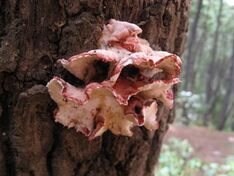Phlebia incarnata
Topic: Biology
 From HandWiki - Reading time: 2 min
From HandWiki - Reading time: 2 min
Short description: Species of fungus
| Phlebia incarnata | |
|---|---|

| |
| Scientific classification | |
| Kingdom: | |
| Division: | |
| Class: | |
| Order: | |
| Family: | |
| Genus: | |
| Species: | P. incarnata
|
| Binomial name | |
| Phlebia incarnata (Schwein.) Nakasone & Burds. (1984)
| |
| Synonyms[1] | |
| |
| Phlebia incarnata | |
|---|---|
| Mycological characteristics | |
| ridges on hymenium | |
| cap is offset | |
| hymenium attachment is not applicable | |
| lacks a stipe | |
| spore print is white | |
| ecology is saprotrophic | |
| edibility: inedible | |
Phlebia incarnata is a species of polypore fungus in the family Meruliaceae. It is inedible.[2]
Taxonomy
The species was originally described as Merulius incarnatus by Lewis David de Schweinitz in 1822.[3] In its taxonomic history, it has been transferred to the genera Cantharellus (1832),[4] Sesia (1891),[5] and Byssomerulius (1974),[6] and renamed as a form of Merulius tremellosus. It was transferred to Phlebia in 1984 when Nakasone and Burdsall synonymized Merulius with Phlebia.[7]
References
- ↑ Phlebia incarnata (Schwein.) Nakasone & Burds. :245, 1984. MycoBank. International Mycological Association. http://www.mycobank.org/BioloMICS.aspx?Table=Mycobank&Rec=64327&Fields=All. Retrieved 2013-10-01.
- ↑ Miller Jr., Orson K.; Miller, Hope H. (2006). North American Mushrooms: A Field Guide to Edible and Inedible Fungi. Guilford, CN: FalconGuides. pp. 434. ISBN 978-0-7627-3109-1.
- ↑ von Schweinitz LD. (1822). "Synopsis fungorum Carolinae superioris" (in de). Schriften der Berlinischen Gesellschaft Naturforschender Freunde 1: 20–131 (see p. 92).
- ↑ von Schweinitz LD. (1832). "Synopsis fungorum in America boreali media degentium". Transactions of the American Philosophical Society 4 (2): 141–316 (see p. 153). doi:10.2307/1004834.
- ↑ Kuntze O. (1891). Revisio generum plantarum. 2. Leipzig, Germany: A. Felix. p. 870.
- ↑ Gilbertson RL. (1974). Fungi that Decay Ponderosa Pine. Tucson, Arizona: University of Arizona Press. p. 45.
- ↑ Nakasone KK, Burdsall Jr HH. (1984). "Merulius, a synonym of Phlebia". Mycotaxon 21: 241–6. http://www.cybertruffle.org.uk/cyberliber/59575/0021/0241.htm.
External links
Wikidata ☰ Q15632503 entry
 |
Licensed under CC BY-SA 3.0 | Source: https://handwiki.org/wiki/Biology:Phlebia_incarnata1 views | ↧ Download this article as ZWI file
 KSF
KSF